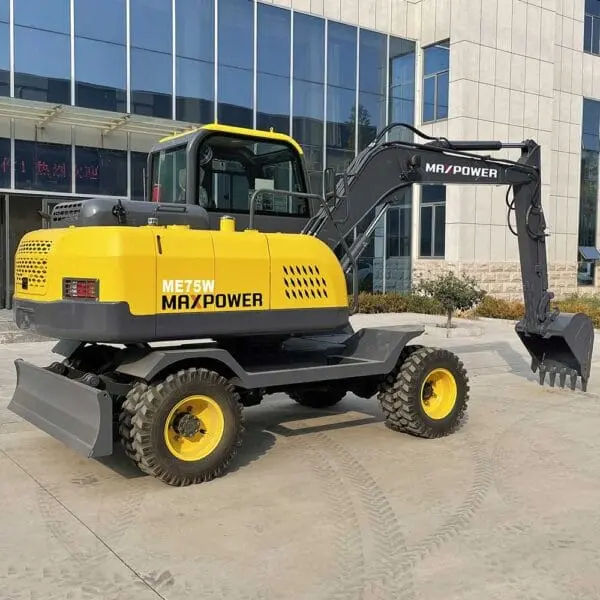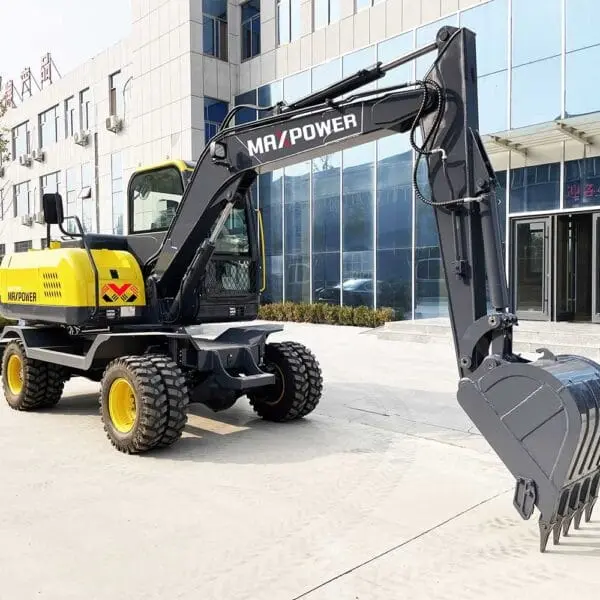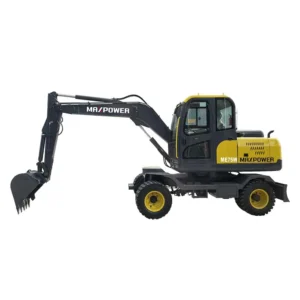Introduction
Wheel excavators are versatile machines that are used in a variety of construction, mining, and forestry applications. They are known for their mobility, maneuverability, and ability to lift and dig in a variety of conditions. However, with so many different wheel excavator models on the market, it can be difficult to choose the right one for your project.
In this blog post, we will discuss some of the factors to consider when choosing a wheel excavator. We will also provide a table that compares the features of different models.
Understanding Wheel Excavators

Wheel excavators are a type of heavy construction equipment that come with rubber tires instead of tracks. They are used in a variety of tasks including digging, material handling, and demolition. Their mobility makes them ideal for urban construction sites, road maintenance, and other applications where maneuverability is a priority.
Advantages of Wheel Excavators
- Mobility: Wheel excavators can travel faster on roads and are easier to transport between job sites.
- Versatility: They can be used in diverse applications from urban construction to landscaping.
- Efficiency: Faster cycle times and the ability to drive on roads can reduce project timelines.
- Lower Ground Damage: Their rubber tires cause less damage to paved surfaces compared to tracked excavators.
Factors to Consider
When choosing a wheel excavator, it is important to consider the following factors:
- Size and weight: The size and weight of the excavator will determine its digging depth, reach, and lifting capacity. You will need to choose an excavator that is large enough to handle the tasks you need to perform.
- Engine power: The engine power will determine the excavator’s performance. You will need to choose an excavator with enough engine power to handle the materials you will be excavating.
- Hydraulics: The hydraulics system powers the excavator’s boom, stick, bucket, and other attachments. You will need to choose an excavator with a hydraulics system that is powerful enough to handle the tasks you need to perform.
- Attachments: Wheel excavators can be equipped with a variety of attachments, such as buckets, breakers, and grapples. You will need to choose an excavator that can be equipped with the attachments you need.
- Price: Wheel excavators can range in price from tens of thousands of dollars to hundreds of thousands of dollars. You will need to set a budget and choose an excavator that fits within your budget.
Comparison between wheeled excavators and other excavators
| Feature | Wheeled Excavators | Tracked (Crawler) Excavators | Mini Excavators | Dragline Excavators |
|---|---|---|---|---|
| Mobility | High mobility on paved roads | Limited to rough terrain | High mobility in confined spaces | Very limited (requires assembly) |
| Terrain Suitability | Best for urban and paved environments | Best for rough and uneven terrain | Suitable for small and tight spaces | Suitable for large open-pit mining and dredging |
| Speed | Higher travel speed (up to 25-30 mph) | Slower travel speed (up to 5-6 mph) | Moderate travel speed | Very slow (requires external transport) |
| Ground Impact | Low (rubber tires cause minimal damage) | High (tracks can damage paved surfaces) | Low (due to small size and rubber tracks) | High (large impact on the ground) |
| Versatility | Highly versatile with various attachments | Versatile, particularly in tough conditions | Versatile for small-scale projects | Limited to specific large-scale projects |
| Power and Size | Medium to large size, moderate power | Wide range from medium to very large size | Small to medium size, lower power | Very large size, very high power |
| Typical Applications | Urban construction, road maintenance | Heavy construction, excavation, demolition | Landscaping, small construction, utilities | Mining, dredging, large excavations |
| Operational Efficiency | High in urban settings due to mobility | High in challenging terrains | High for precision and small-scale work | High for large-scale earthmoving tasks |
| Cost | Moderate to high | Varies widely based on size and capability | Lower initial cost | Extremely high (both purchase and operation) |
| Maintenance | Easier and less frequent | More frequent, especially in rough terrain | Easier due to smaller size | Complex and costly |
| Environmental Impact | Lower due to reduced ground damage | Higher due to track impact | Lower due to size and precision | High due to large-scale disruption |
Features to Look for in a Wheel Excavator

Comfort and Ergonomics
Operator comfort is critical for productivity and safety. Look for features such as adjustable seats, climate control, and user-friendly controls.
Advanced Technology
Modern wheel excavators come with advanced technologies like GPS systems, telematics, and automated functions that improve efficiency and accuracy.
Safety Features
Ensure the excavator has robust safety features such as cameras, sensors, and stability controls to protect the operator and the work site.
Fuel Efficiency
Fuel-efficient models can significantly reduce operating costs and environmental impact. Compare the fuel consumption rates of different models.
Maintenance and Support
Consider the availability of parts, ease of maintenance, and the manufacturer’s support network. A reliable service plan can prevent costly downtime.
Conclusion
Selecting the right wheel excavator involves a thorough evaluation of your project needs, budget, and the specific features of various models. By understanding the key considerations and comparing different options, you can choose a wheel excavator that enhances productivity, efficiency, and safety on your job site.
FAQ
What is a wheel excavator used for?
Wheel excavators are used for a variety of tasks including digging, lifting, material handling, demolition, and road maintenance. They are especially useful in urban environments due to their mobility.
How does a wheel excavator differ from a tracked excavator?
The primary difference is the undercarriage. Wheel excavators have rubber tires and are more mobile, causing less ground damage, while tracked excavators have tracks that provide better stability on uneven terrain.
What attachments can be used with a wheel excavator?
Wheel excavators can be equipped with a range of attachments including buckets, grapples, hammers, augers, and more, depending on the task requirements.
How important is fuel efficiency in choosing a wheel excavator?
Fuel efficiency is very important as it impacts the overall operating cost and environmental footprint. Efficient models can save money in the long run.
What are the main safety features to look for in a wheel excavator?
Key safety features include cameras, sensors, stability controls, ROPS/FOPS cabins, and emergency stop functions. These features help ensure the safety of the operator and surrounding personnel.








-150x150.webp)
